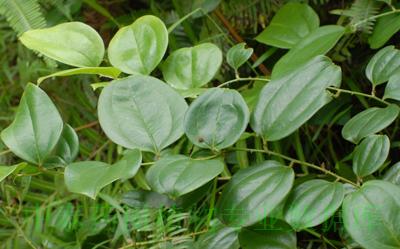| [English Name] | Chinaroot Greenbrier Rhizome | |
| [Chinese Name] | 金刚刺 | |
| [Pinying Name] | Jingangci | |
| [Latin Name] | Smilacis Chinae Rhizoma | |
| [Genera] | Liliaceae | |
| [Efficacy] | qufengshiyao | |
| [Pictures] | Plant picture | Drug picture |

|
||
| [Alias] | ||
| [Source] | ||
| [Plant morphology] | ||
| [Distribution] | ||
| [Gathering and processing] | ||
| [Characteristics] | ||
| [Ecology] | It grows in low moutain bushes or vellay shoreditch. | |
| [Chemical composition] | ||
| [Pharmacological activities] |
1. Antiinflammatory: Bamboo brier show anti-inflammatory activity on prophase and advanced stage inflammation[1,2]. 2. Antibiosis: Different polarity extract show antibiosis or induce mutation on B.megaterumi, B.subtilis, escherichia coli, staphylococcus aureus and Bacillus thuringiensis[3,4]. 3. Other Effects: Bamboo brier can inhibit platelet aggregation and prolong intrinsic coagulation time[5]. Its flavonoid glycoside show evident anticancer activity[6]. Sarsasapogenin has stay caducity action[4]. |
|
| [Clinical trial] | ||
| [Properties] | ||
| [Medical and other Uses] | ||
| [Dosage] | ||
| [Cautions] | ||
| [Traditional usage] | ||
| [Toxicological studies] | ||
| [Pharmaceutical preparations] | ||
| [References] |
Pharmacologic Actions: [1] Lv Yongning, Chen Dongsheng, Deng Jungang. Journal of Chinese Medicinal Materials, 2003,26(5):344. [2] Shu Xiaoshun, Gao Zhonghong, Yang Xiangliang. Journal of Ethnopharmacology, 2006:327. [3]Kim SW,Son KH,Chung KC. Yakhak Heechi, 1989,33 (5):285. [4] Liu Shiwang, You Bigang, Xu Yanxia. Resource Development & Market, 2004,20(5):328. [5] Lv Yongning, Chen Dongsheng, Xu Chuhong. Chinese Journal of Hospital Pharmacy, 2002,22(9):538. [6] Li Yuanli, Gan Guoping, Zhang Huizhan. Ethnopharmacology,2007,113(1):115. [7] Yang Ming, Ji Hui, Dai Shengjun. Chinese Traditional and Herbal Drugs, 2007,38(2):245. |
|